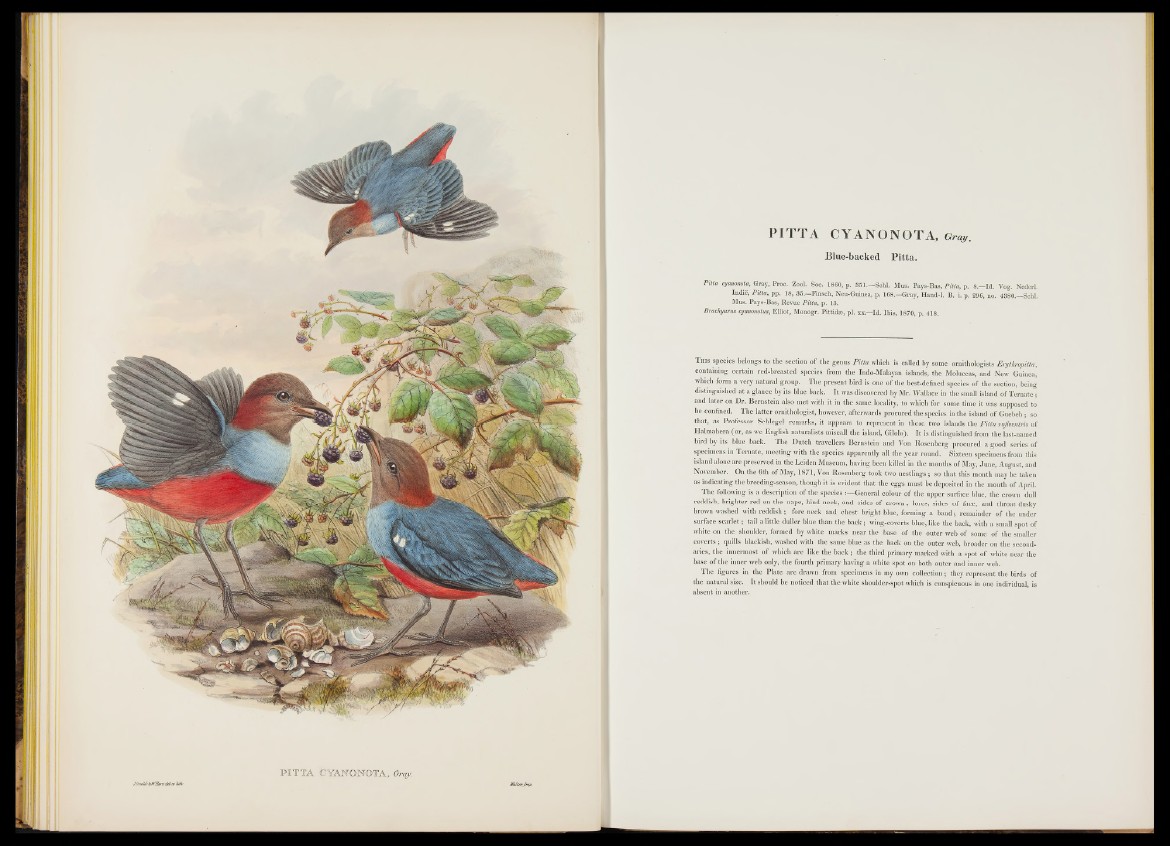
J.G ffuld'bW H int! ¿¿beò lü /v
P IT IA CYANOKOTA, Orqy.
PITTA CYANONOTA, Gray.
Blue-backed P itta .
Pilla cÿanonota, Gray, Proc. Zool. Soc. 1860, p. 351.—Schl. Mus. Pays-Bas, Pilla, p. 8.—Id. Vog. Nederl.
ludië, Pilla, pp. 18, 35.—Finsch, Neu-Guiuea, p. 168.—Gray, Hand-1. B. i. p. 296, no. 4380.—Schl.
Mus. Pays-Bas, Revue Pitta, p. 13.
Brachyurus cyanonotus, Elliot, Monogr. PIttidæ, pl. x x—Id. Ibis, 1870, p. 418.
T his species belongs to the section o f the genus Pitta which is called by some ornithologists Erythropitta,
containing certain red-breasted species from the Indo-Malayan islands, the Moluccas, and New Guinea,
which form a very natural group. The present bird is one o f the best-defined species of the section, being
distinguished a t a glance by its blue hack. I t was discovered by M r. Wallace in the small island of T e ru a te ;
and later on Dr. Bernstein also met with it in the same locality, to which for some time it was supposed to
be confined. The latter ornithologist, however, afterwards procured the species in the island o f Guebeh ; so
that, as Professor Schlegel remarks, it appears to represent in these two islands the Pitta rufiaentris of
Halmahera (o r, as we English naturalists miscall the island, Gilolo). I t is distinguished from the last-named
bird by its blue back. The Dutch travellers Bernstein and Von Bosenberg procured a good series of
specimens in Ternate, meeting with the species apparently all the year round. Sixteen specimens from this
island alone are preserved in the Leiden Museum, having been killed in the months o f May, June, August, and
November. On the 6th o f May, 1871, Von Rosenberg took two nestlings ; so that this month may be taken
as indicating the breeding-season, though it is evident that the eggs must be deposited in the month o f April.
The following is a description o f the species :— General colour of the upper surface blue, the crown dull
reddish, brighter red on the nape, hind neck, and sides o f crown; lores, sides o f face, and throat dusky
brown washed with red d ish ; fore neck and chest bright blue, forming a b a n d ; remainder o f the under
surface sc a rle t; tail a little duller blue than the b a ck ; wing-coverts blue, like the back, with a small spot of
white on the shoulder, formed by white marks near the base o f the outer web o f some o f the smaller
coverts ; quills blackish, washed with the same blue as the back on the outer web, broader on the secondaries,
the innermost o f which are like the back ; the third primary marked with a spot o f white near the
base o f the inner web only, the fourth primary having a white spot on both outer and inner web.
The figures in the Plate are drawn from specimens in my own collection; they represent the birds o f
the natural size. I t should he noticed th at the white shoulder-spot which is conspicuous in one individual, is
absent in another.